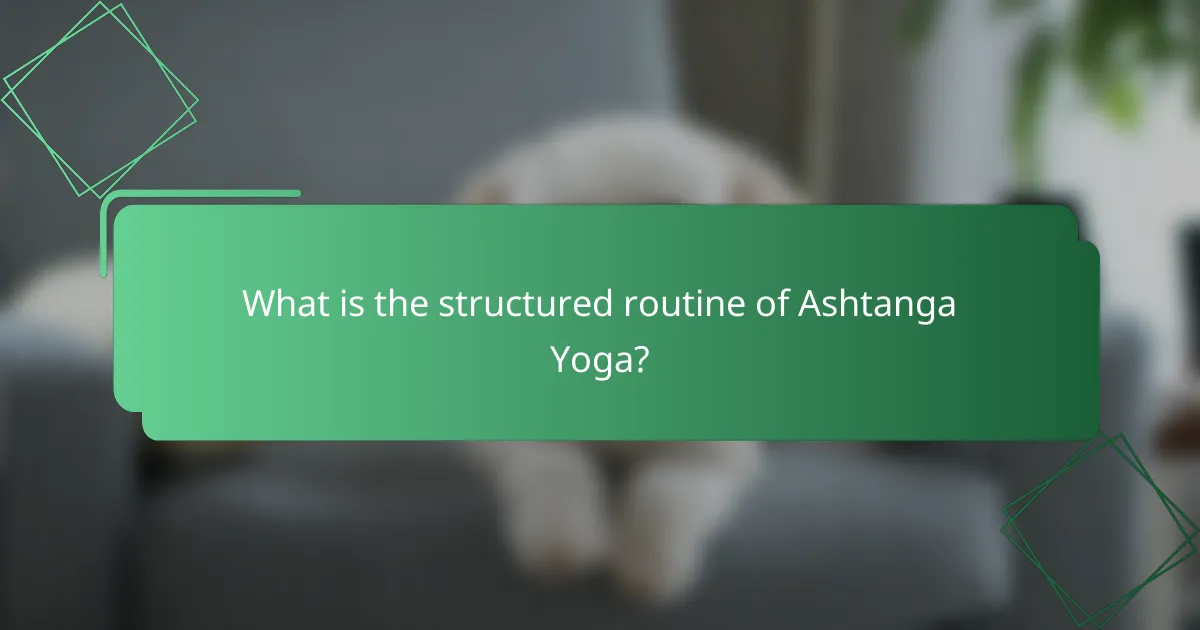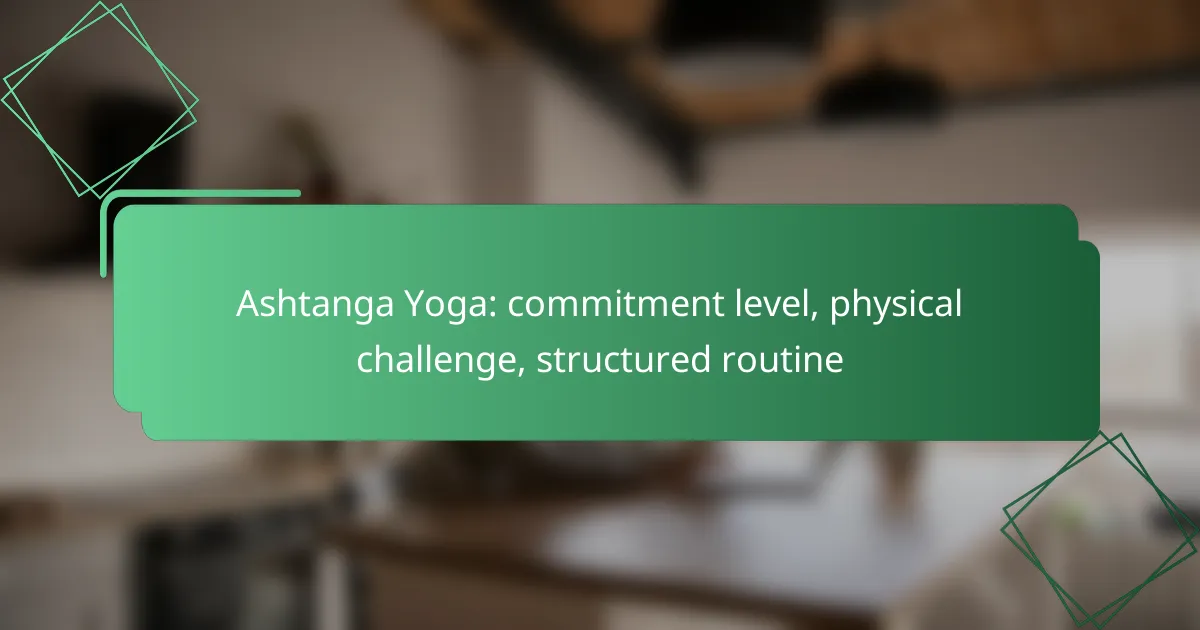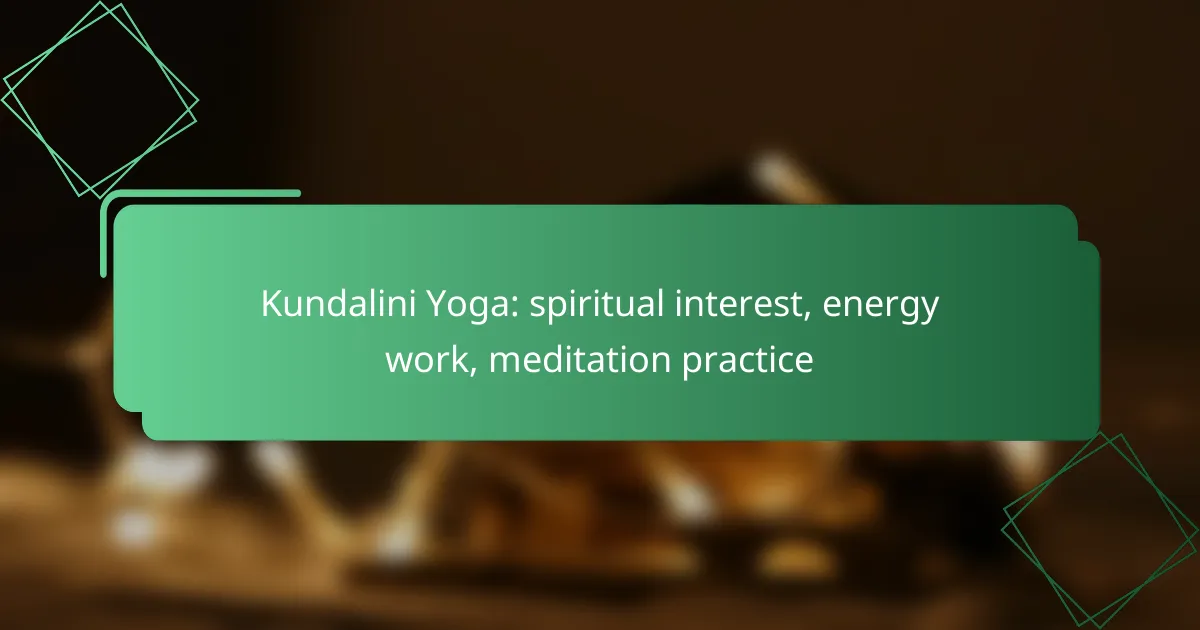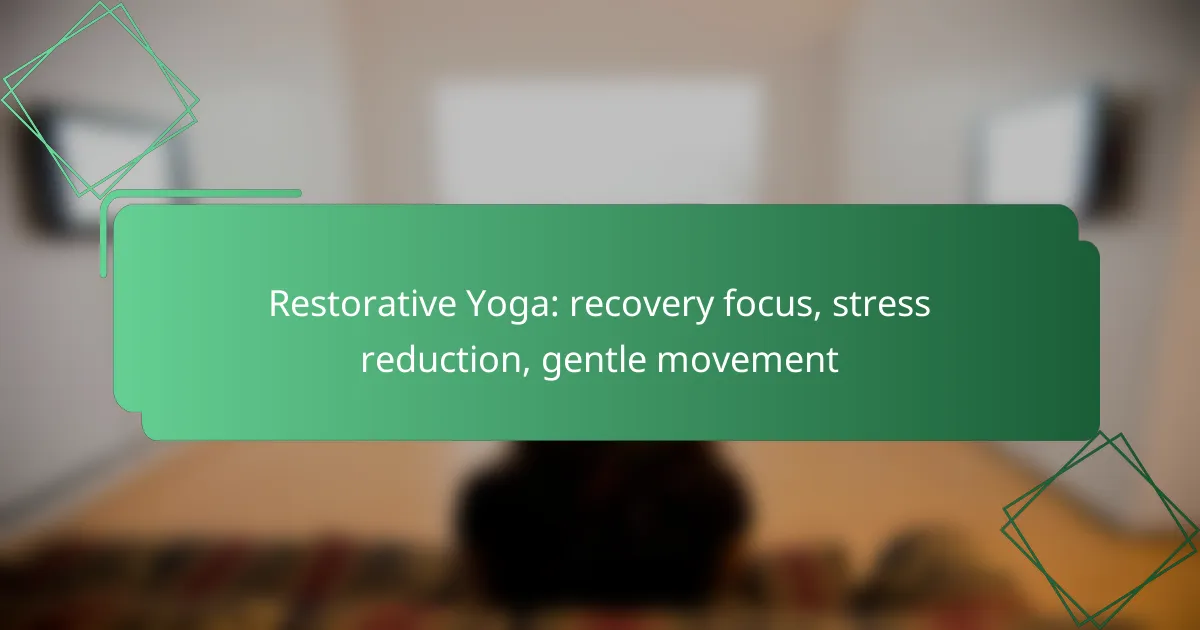Ashtanga Yoga is a rigorous practice that demands a high level of commitment and discipline from its practitioners. With a structured routine consisting of specific postures performed in a precise order, it presents a significant physical challenge that enhances strength, flexibility, and endurance. This methodical approach not only fosters physical growth but also cultivates mental focus, making dedication essential for achieving mastery in the practice.

What is Ashtanga Yoga commitment level?
The commitment level for Ashtanga Yoga is significant, requiring practitioners to engage in a consistent and disciplined practice. This style emphasizes a structured routine that can be physically demanding, making dedication essential for progress and mastery.
Daily practice requirement
Ashtanga Yoga typically requires a daily practice, ideally six days a week, with Sundays reserved for rest. Each session can last anywhere from 60 to 90 minutes, depending on the practitioner’s level and the specific series being practiced.
Consistency is key; missing days can disrupt the flow and make it challenging to maintain the rhythm of the practice. Beginners might start with fewer days per week but should aim to gradually increase their commitment as they become more comfortable with the routine.
Long-term dedication
Long-term dedication to Ashtanga Yoga is crucial for deepening one’s practice and achieving physical and mental benefits. Practitioners often commit to years of training, progressing through the series at their own pace.
As practitioners advance, they may find that their understanding of the poses and breathing techniques deepens, leading to greater physical strength and flexibility. This journey requires patience and a willingness to embrace challenges along the way.
Community support
Community support plays a vital role in maintaining commitment to Ashtanga Yoga. Many practitioners find motivation and encouragement through local studios or online groups that share similar goals and experiences.
Participating in group classes or workshops can enhance the practice, providing opportunities for feedback and camaraderie. Engaging with a community helps to foster accountability and can make the commitment feel less daunting.

How physically challenging is Ashtanga Yoga?
Ashtanga Yoga is considered physically challenging due to its demanding sequences and emphasis on strength, flexibility, and endurance. Practitioners often experience significant physical exertion as they progress through the structured routines, which can lead to both improvements and potential injuries.
Intensity of practice
The intensity of Ashtanga Yoga varies based on the practitioner’s level and the specific series being practiced. Beginners may find the initial series manageable, but as they advance, the poses become increasingly strenuous and require greater strength and stamina. Regular practitioners often engage in sessions lasting from 60 to 90 minutes, which can be quite taxing.
To gauge intensity, consider your heart rate and breath control during practice. If you find yourself struggling to maintain a steady breath, you may be pushing too hard.
Skill progression
Skill progression in Ashtanga Yoga is structured around a series of poses that build on one another. Each series must be mastered before moving on to the next, ensuring a solid foundation in strength and flexibility. This methodical approach helps practitioners develop their skills gradually and safely.
Common milestones include mastering foundational poses like Downward Dog and progressing to more advanced postures such as the handstand. Practitioners should focus on consistency and patience, as rushing through the series can lead to injury.
Common injuries
Ashtanga Yoga can lead to common injuries, particularly in the shoulders, wrists, and lower back, often due to improper alignment or overexertion. Beginners are especially susceptible if they attempt advanced poses without adequate preparation. It’s crucial to listen to your body and modify poses as needed.
To minimize the risk of injury, ensure proper warm-up routines and consider working with a qualified instructor. Additionally, using props can help maintain alignment and support in challenging poses.

What is the structured routine of Ashtanga Yoga?
The structured routine of Ashtanga Yoga consists of a series of specific postures performed in a precise order, emphasizing breath control and physical alignment. This methodical approach helps practitioners build strength, flexibility, and mental focus over time.
Primary series overview
The Primary Series, known as Yoga Chikitsa, is designed to detoxify and align the body. It typically includes around 75 postures, focusing on foundational poses that promote strength and flexibility. Practitioners often spend several months to years mastering this series before progressing to more advanced levels.
Sequence of postures
The sequence of postures in Ashtanga Yoga follows a set pattern, starting with sun salutations, followed by standing poses, seated poses, and finishing postures. Each session usually lasts between 90 minutes to two hours, requiring commitment to complete the entire routine. Consistency is key, as each posture builds on the previous ones.
Breath synchronization
Breath synchronization, or Ujjayi breathing, is essential in Ashtanga Yoga. Practitioners coordinate their movements with their breath, inhaling and exhaling at specific points during the sequence. This technique not only enhances physical performance but also cultivates a meditative state, helping to maintain focus throughout the practice.

What are the prerequisites for starting Ashtanga Yoga?
To start Ashtanga Yoga, you should have a basic level of physical fitness and a readiness to commit mentally. This practice is both physically demanding and requires a structured approach, making it essential to prepare adequately.
Physical fitness level
A good physical fitness level is crucial for Ashtanga Yoga, as it involves a series of challenging postures that require strength, flexibility, and endurance. Beginners should ideally be comfortable with basic yoga poses and should engage in regular physical activity, such as running, swimming, or strength training, to build a solid foundation.
If you are new to yoga, consider starting with gentler styles to develop your body awareness and flexibility before diving into the rigorous Ashtanga sequence. Regular practice of foundational poses can help ease the transition into more complex movements.
Mental readiness
Mental readiness is equally important when starting Ashtanga Yoga, as the practice demands focus, discipline, and a commitment to a structured routine. You should be prepared to dedicate time and effort to learn and practice the series consistently, as progress can be gradual.
Establishing a routine that includes regular practice sessions, ideally several times a week, can enhance your mental commitment. Setting realistic goals and being patient with your progress will help you stay motivated and engaged in your Ashtanga journey.

How to choose the right Ashtanga Yoga studio?
Selecting the right Ashtanga Yoga studio involves considering factors like instructor qualifications, class size, and the overall environment. These elements can significantly impact your practice and commitment level.
Instructor qualifications
When choosing an Ashtanga Yoga studio, it’s crucial to evaluate the instructors’ qualifications. Look for teachers who have completed a recognized training program, ideally with experience in the Ashtanga tradition. Many reputable studios will display their instructors’ credentials and teaching lineage.
Additionally, consider the instructor’s teaching style and approach. Some may focus more on alignment, while others emphasize flow and breath. Attending a trial class can help you determine if the instructor’s style resonates with your personal practice goals.
Class size and environment
The class size and environment play a vital role in your Ashtanga Yoga experience. Smaller classes often allow for more personalized attention, which can enhance your learning and practice. Conversely, larger classes may provide a more energetic atmosphere but can limit individual feedback.
Pay attention to the studio’s ambiance as well. A clean, well-ventilated space with appropriate lighting can create a more inviting environment. Check if the studio offers amenities like mats, props, and changing facilities, as these can influence your overall comfort during classes.

What are the benefits of Ashtanga Yoga?
Ashtanga Yoga offers numerous benefits, including enhanced physical fitness, mental clarity, and emotional balance. Its structured routine promotes discipline and commitment, making it an effective practice for those seeking both physical and spiritual growth.
Physical health improvements
Ashtanga Yoga significantly improves physical health through its rigorous and dynamic sequences. Practitioners often experience increased flexibility, strength, and endurance as they progress through the series of postures. Regular practice can lead to better posture and alignment, reducing the risk of injury.
In addition to flexibility and strength, Ashtanga Yoga can enhance cardiovascular health. The continuous flow of movements elevates the heart rate, promoting better circulation and overall heart function. This practice can also aid in weight management by burning calories effectively during sessions.
To maximize physical health benefits, aim for consistent practice, ideally three to six times a week. Focus on mastering foundational postures before advancing to more challenging ones. Remember to listen to your body and avoid pushing beyond your limits to prevent injuries.










